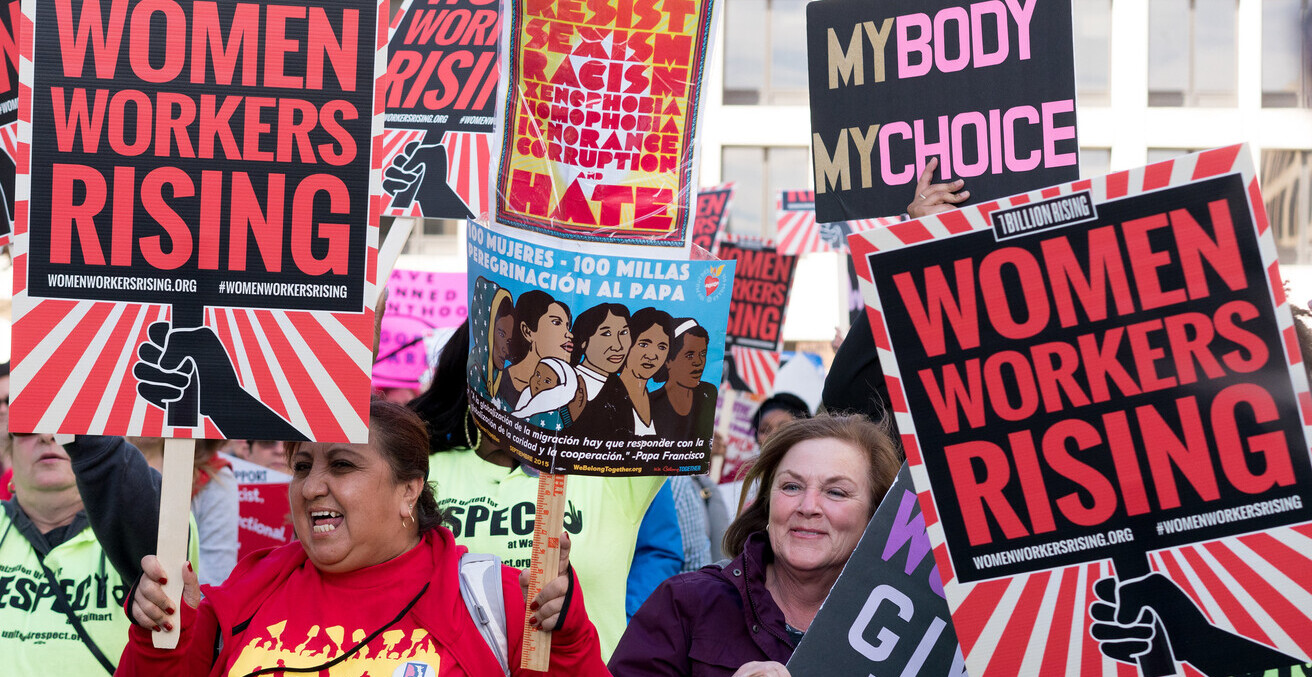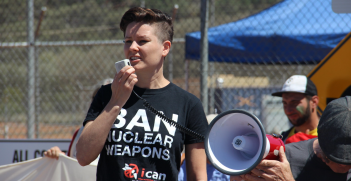Missing Women: Why Countries Won’t Recover From COVID-19 Until Some Serious Gender Work is Done

Feminists have always argued that women are at the heart of national economic systems despite women’s labour rarely being officially recognised. Amid a global pandemic that has pushed so many to the brink, we must push for discussions about “the economy” to include thinking about gender.
The theme of this year’s International Women’s Day is #BreakTheBias, providing a call to action for accelerating gender parity. “Imagine a gender equal world,” we are asked, a world “free of bias, stereotypes and discrimination. A world that is diverse, equitable, and inclusive.”
In a world of widespread gender inequality, celebrating the social, economic, cultural, and political achievements of women is always important. International Women’s Day provides an opportunity to listen to women as they tell the stories of their lives, and to take stock of the wonderful work women everywhere have achieved and are achieving. Women leaders have been applauded for their handling of the COVID-19 pandemic throughout the world, demonstrating wisdom and compassion in their leadership of communities, agencies, firms, and countries. Women and girls are more educated than ever. Women are more prominent today in positions of power and decision-making, and many command increasingly better working conditions and employment expectations. Women are challenging entrenched, violent, exclusive systems in creative and subversive ways everywhere. There is much to celebrate.
For the first time in its reporting history, last year Australia’s Workplace Gender Equality Agency (WGEA) recorded an increase in the number of women managers, up to 41 percent. Fifty-one percent of Australian employers provide paid domestic violence leave, and 80 percent offer paid parental leave during which they also pay parents’ superannuation contributions. Australia’s Gender Equality Score Card also saw a small reduction in the gender pay gap, at 22.8 percent, down from 23.3 percent in 2020.
The economics of this year’s International Women’s Day #BreakTheBias theme is worth focusing on for two key reasons. Firstly, women’s economic lives are central in and to the social, political, and cultural achievement of gender equality. This goes without saying but is worth repeating, not least because national policy responses to the COVID-19 pandemic in Australia and overseas have been “missing” gender. Second, the costs of economic crisis fall heavily on women. As we raise our heads above the parapet of a global pandemic, it seems a good time to be reminded that crises cannot be described and understood in economic terms alone. The relationship between gender, economic crisis, and the COVID-19 pandemic remains perhaps one of the most important conversations that is, officially, not happening.
Breaking biases doesn’t just happen “out there.” Throughout the pandemic, national policy-making has struggled, however, to establish a clear, well-followed focus on women, gender equality, and social protection. Australians have contended with the increasing obviousness of some uncomfortable home truths over the last two years, including persistent gender gaps, pervasive gender-based discrimination and bias, and worrying increases in the prevalence of domestic and family violence.
The “essential” nature of care work, and the industries, families, and individuals that support it, has sat at the core of the COVID-19 outbreak and our responses to it. Women account for 77 percent of employees in health care and social assistance in Australia. From 2020 to 2021, women took 88 percent of all primary carer’s leave. Yet, despite warnings in 2020 of a potential exodus of women from the workforce, especially women with young children, Australian national policy was slow to recognise the need for targeted assistance for childcare services. Childcare workers continue to be some of Australia’s lowest paid professionals, with salaries starting at little over minimum wage. Faced with increasing job insecurity, many left their jobs during the pandemic, especially casual workers excluded from entitlements to JobKeeper. Overrepresented in sectors affected by the pandemic and with higher levels of caring responsibilities, young women have reported higher levels of unemployment as a result of COVID-19. Women continue to constitute the majority of the lowest-income earners, nationally and globally.
There is little doubt that the COVID-19 pandemic has worsened gender gains for women in a number of sectors. Data from around the world shows that women in the lowest income households and from marginalised groups have borne the brunt of the COVID-19 crisis. The pandemic has illuminated crises of care and capitalist state failings across country examples, pushing underfunded, understaffed health and social services to the brink. As the majority of frontline workers — more than 70 percent, globally — women have risked exposure to infection at staggering levels, while women’s overwhelming responsibilities for reproductive labour — the unpaid labour of household and community care — have compounded their economic insecurity. Much more likely to work part-time, to occupy informal or casualised jobs, or to be working for family, women have encountered a global pandemic with lower pay, reduced job security, fewer training and promotion opportunities, and limited access to social protections.
The COVID-19 crisis has exposed and deepened underlying inequalities in societies around the world. Women’s access to key health services has been reduced. They have faced increased time caring for children — including home-based education — for older people, and for the sick. Families have been isolated, without their usual social connections, and women and girls have lost access to support programmes. Mental health has declined, while general health problems have increased, magnified by the shelving of less urgent hospital procedures. Throughout lockdowns, women and girls have been trapped in insecure and unsafe environments, at heightened risk of violence and abuse.
According to the Global Gender Gap Report 2021, produced by the World Economic Forum (WEF), over the course of the COVID-19 pandemic the gender gap has increased by almost 40 years, to 136 years. Estimates suggest that it could take as much as 268 years to close the gender gap in economic participation and opportunity. In reality, gaps may be between one and four percent wider than reported because the full impact of the pandemic cannot not yet be known.
In Australia in 2021, men were twice as likely to be highly paid than women. Little progress was made on “persistent” and “sizeable” pay gaps across decision-making structures still dominated by men. According to Australia’s Gender Equality Score Card, in 2021, fewer than 50 percent of employers had managed to reduce their pay gap. More than 85 percent of Australian employers paid men more than women in 2021, while women earned on average about 77 percent of men’s earnings.
Thinking about International Women’s Day, and this year’s theme of #BreakTheBias, there is obviously a huge amount of work still to be done locally and globally. As Australians move out of COVID-19 restrictions, the question of whether they are actively building a country where women are less vulnerable, more secure, and in better positions than they have ever been, remains an important one. The COVID-19 pandemic has revealed the cracks in the edifice of Australia’s wealth, but not only, of course, in terms of its gross domestic product. The concentration of vulnerability among women in the population, ongoing gender disparities in earnings and superannuation, high percentages of women working in less well-paid, frequently precarious, often caring-based sectors, and the lack of recognition for women’s caring and unpaid labour – attending to these faultlines is crucial to ensuring Australia’s social wealth, its resilience as a collective, and its future as a national community.
Dr Penny Griffin is Senior Lecturer in Politics and International Relations in the School of Social Sciences at UNSW Sydney. Her work explores the global political economy from a gender perspective, and she is working at the moment on the relationship between gender and economic crisis.
This article is published under a Creative Commons Licence and may be republished with attribution.





